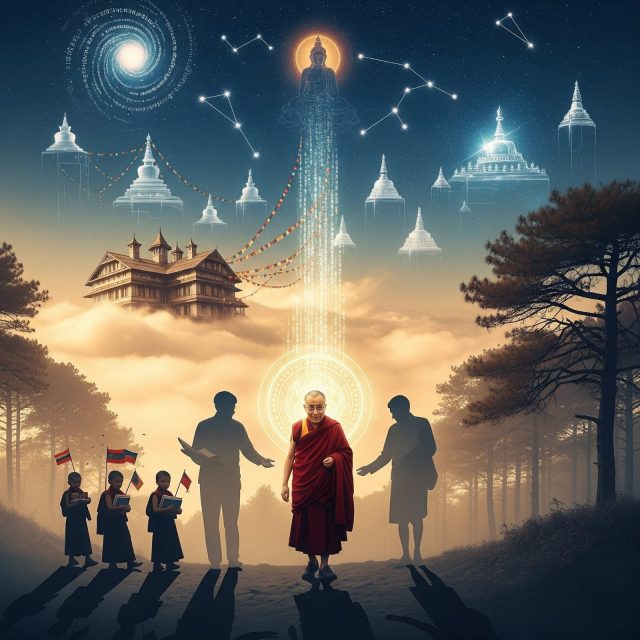 By Rajat Aikant Sharma
By Rajat Aikant Sharma
Mussoorie is a place where mist and memory intertwine. Its forests, steep lanes, and old colonial structures are layered with stories—of British officers and ballroom dances, of literary retreats, of exiles and dreamers. But among them, one story glows like a quiet flame: the year 1959, when His Holiness the 14th Dalai Lama, a sprightly young man of twenty-four, first set foot in India, and Mussoorie became his first home in exile.
Most histories point to Dharamshala as the heart of the Tibetan Government-in-Exile. But before that chapter was written, it was in Mussoorie’s Happy Valley where the first prayers of a displaced Tibet found sanctuary. This is not merely a historic anecdote – it is a living memory, a civilisational crossroad, and, as many residents recall, a moment when the Queen of the Hills was blessed by a radiance beyond ordinary comprehension.
A Young Monk in the Mist
When the Dalai Lama fled Tibet in March 1959, escaping the Chinese crackdown, the Government of India under Jawaharlal Nehru extended asylum. Birla House in Happy Valley was designated as his temporary residence. Here, the young Tibetan leader began not only the rebuilding of a community but also the careful weaving of a spiritual, cultural, and political identity in exile.
Pramod Kapoor, a senior resident of Mussoorie, recalls that for almost a year His Holiness stayed at Birla House before being shifted to Dharamshala on security considerations. En route to Happy Valley, he was welcomed by students of Hampton Court at Hussain Ganj—a memory captured in photographs in which Mother Xavier, then Superior of CJM Hampton Court, and Dev Raj Kapoor stood among those present.
For a town accustomed to British officers and Indian dignitaries, the presence of this young monk was of a different order. His aura, smiling face, and unpretentious demeanour seemed to carry an energy beyond the ordinary. Philosophically speaking, what people felt may well be described in the language of Advaita Vedanta as a glimpse of Chaitanya—the pure consciousness manifest in human form.
Threads of Memory: Tailors, Teachers, Writers
Mussoorie’s history does not live in archives alone—it breathes through its people. Mr Khanna, a respected senior citizen whose family owned the renowned Jacksons’ Garments and Tailors, remembers how his father was called to Birla House to take measurements for the Dalai Lama and many of his accompanying Lamas. The stitching of robes and garments became part of the tapestry of Tibetan exile—a reminder that local craftsmanship, too, entered history.
Writer and photographer Sanjay Tamta adds further forgotten details. The Priory, Monastery, and Chapel complex originally belonged to the 7th Day Adventist Mission and was later acquired by Pratap Bhan Prakash Singh, the Taluqdar of Katesar. In 1958, before formal exile, Rajmata Savita Kumari invited the Dalai Lama for tea at her estate. At the entrance hung a banner with a doha from the Ramcharitmanas: “Thank you Guruji for visiting your disciple.” Later, His Holiness’s sister stayed in the monastery, which was eventually repurposed as a hostel for the Tibetan Homes Foundation school. These details remind us that exile was not only politics but also hospitality, faith, and human bonds.
Nidhi Bahuguna, an intellectual and writer from Mussoorie, widens the canvas further. She reflects on how Ladakh, Bhutan, and Tibet were once bound to Bharat through shared civilisational roots, sacred geography, and trade. Kailash, Mansarovar, and Minsar were not remote outposts but integral to the Indic imagination. The Dalai Lama’s flight, she observes, was not only a political event but also a civilisational moment—proof that Bharat’s ancient ethos of offering refuge to seekers remained unbroken.
To this, Sanjay Tamta adds a layer of myth and mystery, reminding us that the skeletons of Roopkund are believed by some to be those of General Zorawar Singh’s Dogra army that once ventured towards Tibet. He also notes that Bhutan derives its name from Bhot (Tibet), and that it was Guru Padmasambhava who forged Vajrayana Buddhism and carried it into Tibet. Bahuguna clarifies, with historical precision, that Zorawar Singh’s route was via Kishtwar, not Uttarakhand, as treaties and British interests in the lucrative Pashmina trade kept him away from Garhwal and Kumaon. This dialogue between memory and scholarship shows how personal recollections, myth, and history braid together in Mussoorie’s narrative.
The Little Lhasa
Happy Valley, for a time, became the headquarters of the Tibetan Government-in-Exile. Locals affectionately called it “Little Lhasa”. The Tibetan Homes Foundation, established in the early 1960s, soon became a pillar of community life.
But the beginnings were far more fragile. Old residents recall how the first Tibetans lived in caves and makeshift dwellings along the valley. Their lives were harsh and uncertain, yet they were sustained by the Dalai Lama’s divine presence and their own hard work. Slowly, with time and perseverance, they built schools, monasteries, and small businesses. Today, they are self-sufficient—yet the roots of that resilience lie in those early days of struggle in Mussoorie.
Pramod Kapoor remembers an affable director, possibly Tsering, who was warmly loved in town. Others recall that the Tibetans were never seen as outsiders; they became neighbours, colleagues, and friends. The British may have left behind promenades and clubs, but the Tibetans gave Mussoorie prayer flags, chants, and momos. Even now, the fluttering flags in Happy Valley are not mere decoration—they are the echoes of faith and survival, carried on mountain winds.
Some travel accounts even describe Mussoorie as the Dalai Lama’s “desperate year”—a period of uncertainty and tension, yet also one in which the world’s gaze briefly turned to this quiet hill town. Birla House was requisitioned by the Indian government, and here the Dalai Lama held regular interactions. To townspeople, he was not only a leader in exile but also a teacher, a presence who engaged openly with those around him.
This is the true Mussoorie–Tibetan–Dalai Lama connection: one of divine blessing and human perseverance.
The Civilisational Question
The exile also raises a deeper question about civilisational frontiers. As Nidhi Bahuguna notes, the British never grasped the subtle bonds of geography, trade, and faith that tied Ladakh, Tibet, and Bharat. For them, the Himalayas were borders to be drawn; for ancient India, they were bridges—the abode of deities, the source of rivers, the gateways to higher realms.
Modern China shifted its gaze differently. Where older emperors acknowledged ties, Communist China advanced expansionism. Tibet, land of Avalokiteshvara, tragically became a zone of conflict.
Archival records highlighted by Bahuguna show how Nehru’s idealism shaped policy. The Panchsheel Agreement of 1954 saw India relinquishing historic rights in Tibet, even as Tibetans themselves were excluded from negotiations. As scholar Claude Arpi notes: “India lost all the rights it had in Tibet since the beginning of the 20th century.” This backdrop makes the Dalai Lama’s exile not only a personal story but part of a geopolitical redefinition of Asia.
Encounters with Radiance — Dr Sunil and Dr Venu Sanon
Among Mussoorie’s most respected citizens, Dr Sunil Sanon is remembered not only as a brilliant physician but also as a social worker, intellectual, and humanitarian. Founder of the NGO Divine Trust, he has dedicated his life to both medical service and community welfare. His wife, Dr Venu Sanon, herself a remarkable doctor, has been his lifelong partner in these journeys. Together, from the mid-1980s, the couple began serving the Tibetan Homes Foundation (THF) in Happy Valley as visiting doctors, devoting every Wednesday for four to five hours to the care of Tibetan children and families.
It was through this quiet, consistent service that destiny prepared a moment in 1995—an encounter Dr Sanon still recalls as the most luminous of his life.
At a large gathering, His Holiness the Dalai Lama arrived. Dr Sanon carried a shawl and garland as tokens of respect. Unknowingly, following the usual Indian custom, he placed them gently over the Dalai Lama’s neck rather than handing them into his palms. At that very instant, he heard a strange whooshing sound rush into his ears, unlike anything he had ever experienced. Only much later did he learn that in Tibetan tradition, such offerings are always placed in the hands of the divine master, never directly on his body—perhaps because he is not seen merely as a person but as a living embodiment of Avalokiteshvara, the Bodhisattva of Compassion.
What happened next was no less extraordinary. When His Holiness extended his hands, Dr Sanon instinctively clasped them with both of his own. It was a teaching he had learned as a child: if you touch a realised being, use both hands, so no blessing can escape. In that instant, he describes, an energy like no other surged through him—an “otherworldly aura,” as though compassion itself had entered his veins. The sound, the lightness, the vibration—all marked a mystical threshold.
The Tibetan crowd witnessed this. And when the Dalai Lama left, something unforgettable unfolded. As Dr Sanon and Dr Venu walked towards their Ambassador car, the entire gathering of Tibetans—men, women, monks, children—ran towards them. With tears streaming, they caught hold of Dr Sanon’s hands, kissed them, pressed them against their foreheads, and wept as though through him they were still touching the Dalai Lama. It was a moment of profound sentiment, a testimony to the depth of love Tibetans hold for His Holiness.
For Dr Sanon, this was not just a passing event—it was the culmination of a spiritual journey that began years earlier, when a meeting with Indira Gandhi had led him to connect with Tibetan trusts and institutions, eventually making those regular Wednesdays at Tibetan Homes Foundation (THF) part of his life. And then, one day, came this luminous blessing.
Even decades later, speaking from the United States, Dr Sanon’s voice trembles when he recalls it. “It was not simply meeting a person—it was touching compassion itself.” The aura of that day, he says, has never left him.
Mussoorie’s Blessing
For Mussoorie, the Dalai Lama’s stay was more than a historical footnote—it was a blessing. This town, perched between mist and sky, became the cradle where Tibet first found refuge in India. Its people—tailors, teachers, aristocrats, schoolchildren—wove their lives, however briefly, into the story of a civilisation in exile.
As Pramod Kapoor rightly reflects, Mussoorie played a pivotal role in rehabilitating Tibetans. The ethos of extending refuge, he reminds us, should guide Mussoorie today as well, especially when natural disasters displace local families. Just as it once sheltered Tibet, so too must it shelter its own.
History is not only what happened then, but what we choose to carry forward now.
Conclusion: A Whisper in the Mist
If you walk through Happy Valley today, the monastery bells still ring, the prayer flags still flutter, and the scent of momo stalls drifts across the lanes. Tourists may pass unaware, but the hills remember. For it was here that a young monk, radiant and grounded, carried the weight of a nation and yet radiated peace like the sun rising above clouds.
Mussoorie, in its quiet way, became a station of history, faith, and resilience. And perhaps, as Vedanta would remind us, in remembering him we are not merely recalling an event—we are touching the very possibility of consciousness flowering in human form.
The Dalai Lama is a Nobel Laureate, yes. But that is incidental. His true significance is not in prizes or politics but in presence. He is a bridge between suffering and compassion, between exile and belonging, between the human and the divine. Mussoorie was fortunate to host him; and in return, it carries forever the whisper of his radiance in its mist.
(Rajat Aikant Sharma is a writer and photojournalist exploring culture, history, and human stories. Beyond print, he creates digital content, posters, and social campaigns that extend his editorial voice into the world of influencer engagement and brand storytelling.)







